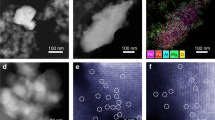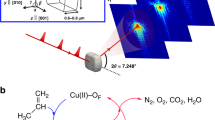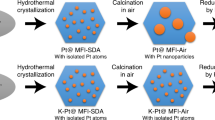Abstract
Tungstated zirconia is a robust solid acid catalyst for light alkane (C4–C8) isomerization. Several structural models for catalytically active sites have been proposed, but the topic remains controversial, partly because of the absence of direct structural imaging information on the various supported WOx species. High-angle annular dark-field imaging of WO3/ZrO2 catalysts in an aberration-corrected analytical electron microscope allows, for the first time, direct imaging of the various species present. Comparison of the relative distribution of these WOx species in materials showing low and high catalytic activities has allowed the deduction of the likely identity of the catalytic active site—namely, subnanometre Zr–WOx clusters. This information has subsequently been used in the design of new catalysts, in which the activity of a poor catalyst has been increased by two orders of magnitude using a synthesis procedure that deliberately increases the number density of catalytically relevant active species.
This is a preview of subscription content, access via your institution
Access options
Subscribe to this journal
Receive 12 print issues and online access
$259.00 per year
only $21.58 per issue
Buy this article
- Purchase on Springer Link
- Instant access to full article PDF
Prices may be subject to local taxes which are calculated during checkout





Similar content being viewed by others
References
Hino, M. & Arata, K. Synthesis of solid superacid of tungsten oxide supported on zirconia and its catalytic action for reactions of butane and pentane. J. Chem. Soc. Chem. Commun. 1259–1260 (1988).
Ono, Y. A survey of the mechanism in catalytic isomerization of alkanes. Catal. Today 81, 3–16 (2003).
Santiesteban, J. G., Vartuli, J. C., Han, S., Bastian, R. D. & Chang, C. D. Influence of the preparative method on the activity of highly acidic WOx/ZrO2 and the relative acid activity compared with zeolites. J. Catal. 168, 431–441 (1997).
Scheithauer, M., Grasselli, R. K. & Knözinger, H. Genesis and structure of WOx/ZrO2 solid acid catalysts. Langmuir 14, 3019–3029 (1998).
Barton, D. G., Soled, S. L., Meitzner, G. D., Fuentes, G. A. & Iglesia, E. Structural and catalytic characterization of solid acids based on zirconia modified by tungsten oxide. J. Catal. 181, 57–72 (1999).
Barton, D. G., Shtein, M., Wilson, R. D., Soled, S. L. & Iglesia, E. Structure and electronic properties of solid acids based on tungsten oxide nanostructures. J. Phys. Chem. B 103, 630–640 (1999).
Baertsch, C. D., Soled, S. L. & Iglesia, E. Isotopic and chemical titration of acid sites in tungsten oxide domains supported on zirconia. J. Phys. Chem. B 105, 1320–1330 (2001).
Baertsch, C. D., Komala, K. T., Chua, Y. H. & Iglesia, E. Genesis of Brønsted acid sites during dehydration of 2-butanol on tungsten oxide catalysts. J. Catal. 205, 44–57 (2002).
Macht, J. et al. Support effects on Brønsted acid site densities and alcohol dehydration turnover rates on tungsten oxide domains. J. Catal. 227, 479–491 (2004).
Wachs, I. E., Kim, T. & Ross, E. I. Catalysis science of the solid acidity of model supported tungsten oxide catalysts. Catal. Today 116, 162–168 (2006).
Kim, T., Burrows, A., Kiely, C. J. & Wachs, I. E. Molecular/electronic structure–surface acidity relationships of model-supported tungsten oxide catalysts. J. Catal. 246, 370–381 (2007).
Ross-Medgaarden, E. I. & Wachs, I. E. Structural determination of bulk and surface tungsten oxides with UV–vis diffuse reflectance spectroscopy and Raman spectroscopy. J. Phys. Chem. C 111, 15089–15099 (2007).
Ross-Medgaarden, E. I. et al. New insights into the nature of the acidic catalytic active sites present in ZrO2-supported tungsten oxide catalysts. J. Catal. 256, 108–125 (2008).
Scheithauer, M. et al. Characterization of WOx/ZrO2 by vibrational spectroscopy and n-pentane isomerization catalysis. J. Catal. 180, 1–13 (1998).
Badlani, M. & Wachs, I. E. Methanol: a ‘smart’ chemical probe molecule. Catal. Lett. 75, 137–149 (2001).
Barton, D. G., Soled, S. L. & Iglesia, E. Solid acid catalysts based on supported tungsten oxides. Top. Catal. 6, 87–99 (1998).
Vartuli, J. C. et al. Characterization of the acid properties of tungsten/zirconia catalysts using adsorption microcalorimetry and n-pentane isomerization activity. J. Catal. 187, 131–138 (1999).
Calabro, D. C., Vartuli, J. C. & Santiesteban, J. G. The characterization of tungsten-oxide-modified zirconia supports for dual functional catalysis. Top. Catal. 18, 231–242 (2002).
Nellist, P. D. & Pennycook, S. J. Direct imaging of the atomic configuration of ultradispersed catalysts. Science 274, 413–415 (1996).
Batson, P. E., Dellby, N. & Krivanek, O. L. Sub-angstrom resolution using aberration corrected electron optics. Nature 418, 617–620 (2002).
Watanabe, M. et al. The aberration corrected JEOL JEM-2200FS FEG-STEM/TEM fitted with an Ω electron energy-filter: performance characterization and selected applications. JEOL News 41, 2–7 (2006).
Nellist, P. D. et al. Direct sub-angstrom imaging of a crystal lattice. Science 305, 1741 (2004).
Wang, S. et al. Dopants adsorbed as single atoms prevent degradation of catalysts. Nature Mater. 3, 143–146 (2004).
Varela, M. et al. Materials characterization in the aberration-corrected scanning transmission electron microscope. Annu. Rev. Mater. Res. 35, 539–569 (2005).
Herzing, A. A., Kiely, C. J., Carley, A. F., Landon, P. & Hutchings, G. J. Identification of active gold nanoclusters on iron oxide supports for CO oxidation. Science 321, 1331–1335 (2008).
Borisevich, A. Y. et al. Dual nanoparticle/substrate control of catalytic dehydrogenation. Adv. Mater. 19, 2129–2133 (2007).
Porcu, M., Petford-Long, A. K. & Sykes, J. M. TEM studies of Nb2O5 catalyst in ball-milled MgH2 for hydrogen storage. J. Alloys Compd. 453, 341–346 (2008).
Cortes-Jácome, M. A. et al. WOx/TiO2 catalysts via titania nanotubes for the oxidation of dibenzothiophene. Chem. Mater. 19, 6605–6614 (2007).
Huang, X., Zhai, H. J., Li, J. & Wang, L. S. On the structure and chemical bonding of tri-tungsten oxide clusters W3On– and W3On (n = 7–10): W3O8 as a potential molecular model for O-deficient defect sites in tungsten oxides. J. Phys. Chem. A 110, 85–92 (2006).
Watanabe, M. et al. Improvements in the X-ray analytical capabilities of a scanning transmission electron microscope by spherical-aberration correction. Microsc. Microanal. 12, 515–526 (2006).
Varela, M. et al. Spectroscopic imaging of single atoms within a bulk solid. Phys. Rev. Lett. 92, 095502 (2004).
Muller, D. A. Structure and bonding at the atomic scale by scanning transmission electron microscopy. Nature Mater. 8, 263–270 (2009).
Yamamoto, T., Orita, A. & Tanaka, T. Structural analysis of tungsten–zirconium oxide catalyst by W K-edge and L1-edge XAFS. X-Ray Spectrom. 37, 226–231 (2008).
Valigi, M. et al. WOx/ZrO2 catalysts part 1. Preparation, bulk and surface characterization. Appl. Catal. A—General 231, 159–172 (2002).
Chang, L. L. Y., Scroger, M. G. & Phillips, B. Condensed phase relations in the systems ZrO2–WO2–WO3 and HfO2–WO2–WO3 . J. Am. Ceram. Soc. 50, 212–216 (1967).
Klenov, D. O. & Stemmer, S. Contributions to the contrast in experimental high-angle annular dark-field images. Ultramicroscopy 106, 889–901 (2006).
Neurock, M. Perspectives on the first principles elucidation and the design of active sites. J. Catal. 216, 73–88 (2003).
Ross-Medgaarden, E. I. Tuning the Electronic and Molecular Structures of Catalytic Active Sites with Oxide Nanodomains (Lehigh University, 2007).
Acknowledgements
This work was supported by the National Science Foundation's Nanoscale Interdisciplinary Research Team (NSF-NIRT) program under grant no. 0609018. Two of the authors (M.S.W. and W.V.K.) acknowledge additional support from SABIC Americas.
Author information
Authors and Affiliations
Contributions
W.Z. devised and carried out the electron microscopy experiments. E.I.R. carried out catalytic performance measurements and prepared the post-impregnation catalyst samples. W.V.K. and M.S.W. prepared some of the catalyst materials. C.J.K. and I.E.W. supervised the project. W.Z. and C.J.K. wrote the paper.
Corresponding author
Supplementary information
Supplementary information
Supplementary information (PDF 1733 kb)
Rights and permissions
About this article
Cite this article
Zhou, W., Ross-Medgaarden, E., Knowles, W. et al. Identification of active Zr–WOx clusters on a ZrO2 support for solid acid catalysts. Nature Chem 1, 722–728 (2009). https://doi.org/10.1038/nchem.433
Received:
Accepted:
Published:
Issue Date:
DOI: https://doi.org/10.1038/nchem.433
This article is cited by
-
Strategic wet-chemical combination of activated charcoal with copper zirconate for enhanced electrocatalytic performance
Journal of Materials Science: Materials in Electronics (2023)
-
Few-layer bismuth selenide cathode for low-temperature quasi-solid-state aqueous zinc metal batteries
Nature Communications (2022)
-
Electron Energy Loss Spectroscopy for Single Atom Catalysis
Topics in Catalysis (2022)
-
Features of the phase composition, acidity, and isomerization activity of Pt/WO3/ZrO2 catalysts
Russian Chemical Bulletin (2020)
-
Size-dependent redox behavior of iron observed by in-situ single nanoparticle spectro-microscopy on well-defined model systems
Scientific Reports (2016)



